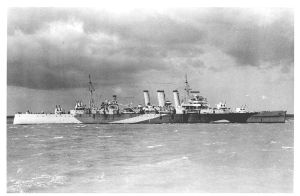
HMS Norfolk was a County-class heavy cruiser of the Royal Navy; along with her sister ship Dorsetshire she was part of a planned four-ship subclass. She served throughout the Second World War, where she was involved in the sinking of the German Navy's battleships Bismarck and Scharnhorst.

HMS Orion was a Leander-class light cruiser which served with distinction in the Royal Navy during World War II. She received 13 battle honours, a record only exceeded by HMS Warspite and matched by two others.

The Fiji-class cruisers were a class of eleven light cruisers of the Royal Navy that saw extensive service throughout the Second World War. Each ship of the class was named after a Crown colony or other constituent territory of the British Commonwealth and Empire. The class was also known as the Colony class, or Crown Colony class. Developed as more compact versions of the preceding Town-class cruisers, the last three were built to a slightly modified design and were sometimes also called the Ceylon class.

HMS Kenya was a Fiji-class cruiser of the Royal Navy. The ship was named after Kenya, a British possession at the time of the ship's construction.
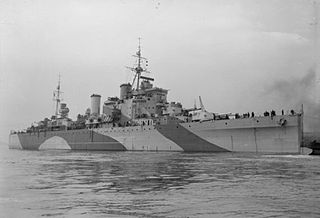
HMS London, pennant number C69, was a member of the second group of the County-class heavy cruisers of the Royal Navy. She and her sisters; Sussex, Shropshire, and Devonshire differed from the earlier group of Counties,, by having a smaller forward superstructure, which was positioned slightly further aft, and little armour plating. HMS London's career spanned over twenty years.
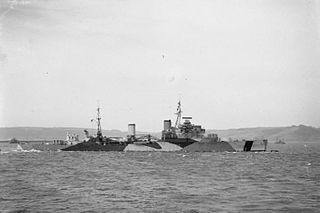
HMS Mauritius, pennant C80, was a Fiji-class light cruiser of the Royal Navy. The ship was built by Swan Hunter, Newcastle upon Tyne. She was named after Mauritius, which was a British colony when she was built and entered service in 1941.

HMS Uganda was a Second World War-era Fiji-class light cruiser launched in 1941. She served in the Royal Navy during 1943 and 1944, including operations in the Mediterranean, and was transferred to the Royal Canadian Navy as HMCS Uganda in October 1944. She served in the Pacific theatre in 1945 and was put into reserve in 1947. When she was reactivated for the Korean War in 1952 she was renamed HMCS Quebec. She was decommissioned for the last time in 1956 and scrapped in Japan in 1961.
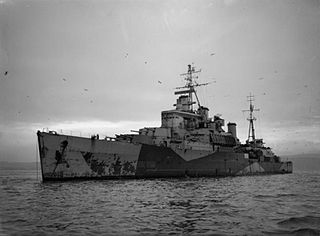
HMS Newfoundland was a Fiji-class light cruiser of the Royal Navy. Named after the Dominion of Newfoundland, she participated in the Second World War and was later sold to the Peruvian Navy.

HMS Scylla was a Dido-class cruiser of the Royal Navy. She was built by Scotts Shipbuilding and Engineering Company, with the keel being laid down on 19 April 1939. She was launched on 24 July 1940, and commissioned 12 June 1942.

HMS Ceylon was a Fiji-class light cruiser of the Royal Navy. She was of the Ceylon sub class, named after the island and British colony of Ceylon. The cruiser saw service in the Atlantic and Pacific theatres during the Second World War. In the postwar era, she participated in actions in Egypt and the Korean War. In 1960 she transferred to the navy of Peru and renamed Coronel Bolognesi. The cruiser was scrapped in 1985.
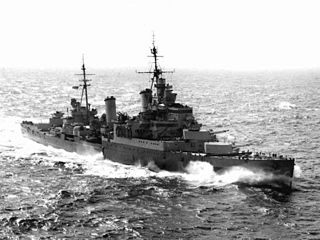
HMS Sheffield was one of the Southampton sub class of the Town-class cruisers of the Royal Navy during the Second World War. She took part in actions against several major German warships. Unlike most Royal Navy ships of her time, her fittings were constructed from stainless steel instead of the more traditional brass. This was an attempt to reduce the amount of cleaning required on the part of the crew. Her nickname, the "Shiny Sheff", stemmed from this. A prototype radar system was placed into service in August 1938 on the Sheffield. It was the first vessel in the Royal Navy to be so equipped.

The fourth HMS Comus was a C-class light cruiser of the Royal Navy that saw service in World War I. She was part of the Caroline group of the C class.
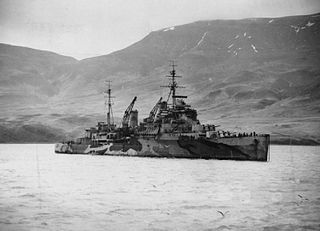
HMS Trinidad was a Royal Navy Fiji-class light cruiser. She was lost while serving in the Arctic on convoy duty after being damaged escorting PQ 13 in 1942.
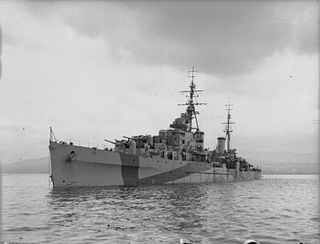
HMS Bellona was the name ship of her sub-class of light cruisers for the Royal Navy. She was the first of the fourth group of Dido-class cruisers. Built to a modified design with only four twin 5.25-inch turrets, but with remote power control for quicker elevation and training, combined with improved handling and storage of the ammunition. The light AA was improved over earlier Dido cruisers, with six twin 20mm Oerlikons and three quadruple 40mm "pom pom".

HMS York was the lead ship of her class of two heavy cruisers built for the Royal Navy in the late 1920s. She mostly served on the North America and West Indies Station before World War II. Early in the war the ship escorted convoys in the Atlantic and participated in the Norwegian Campaign in 1940. York was transferred to the Mediterranean theatre in late 1940 where she escorted convoys and the larger ships of the Mediterranean Fleet. She was wrecked in an attack by Italian explosive motorboats of the 10th Flotilla MAS at Suda Bay, Crete, in March 1941. The ship's wreck was salvaged in 1952 and scrapped in Bari.

HMS Gambia was a Fiji-class light cruiser of the Royal Navy. She was in the service of the Royal New Zealand Navy (RNZN) as HMNZS Gambia from 1943 to 1946. She was named after the then Crown colony of the Gambia, and has been the only ship of the Royal Navy to bear the name.

HMS Swiftsure was one of three Minotaur-class light cruisers built for the Royal Navy during the Second World War. She was laid down by Vickers Armstrong at Newcastle upon Tyne on 22 September 1941, launched on 4 February 1943 by Lady Wake-Walker and commissioned on 22 June 1944. The first of a new Minotaur class, a development of the later Colony class with extra beam and a fifth twin 4 inch turret. Swiftsure was the last Royal Navy cruiser completed during World War II and was the first British cruiser designed around the concept of an operations room and modern radar, with sensor screens and communications positioned for efficient operation. During her service in the Pacific in 1945, she proved the most efficient anti-aircraft cruiser in the fleet, and was the first Royal Navy cruiser with the 274 lock-and-follow radar targeting system for her main armament.

HMS Coventry was a C-class light cruiser of the Royal Navy, named after the English city of Coventry. She was part of the Ceres group of the C-class of cruisers.

HMS Capetown was a C-class light cruiser of the Royal Navy, named after the South African city of Cape Town. So far she has been the only ship of the Royal Navy to bear the name. She was part of the Carlisle group of the C-class of cruisers.

HMS Nigeria was a Fiji-class light cruiser of the Royal Navy completed early in World War II and served during that conflict. She was named after the British colony of Nigeria.





















